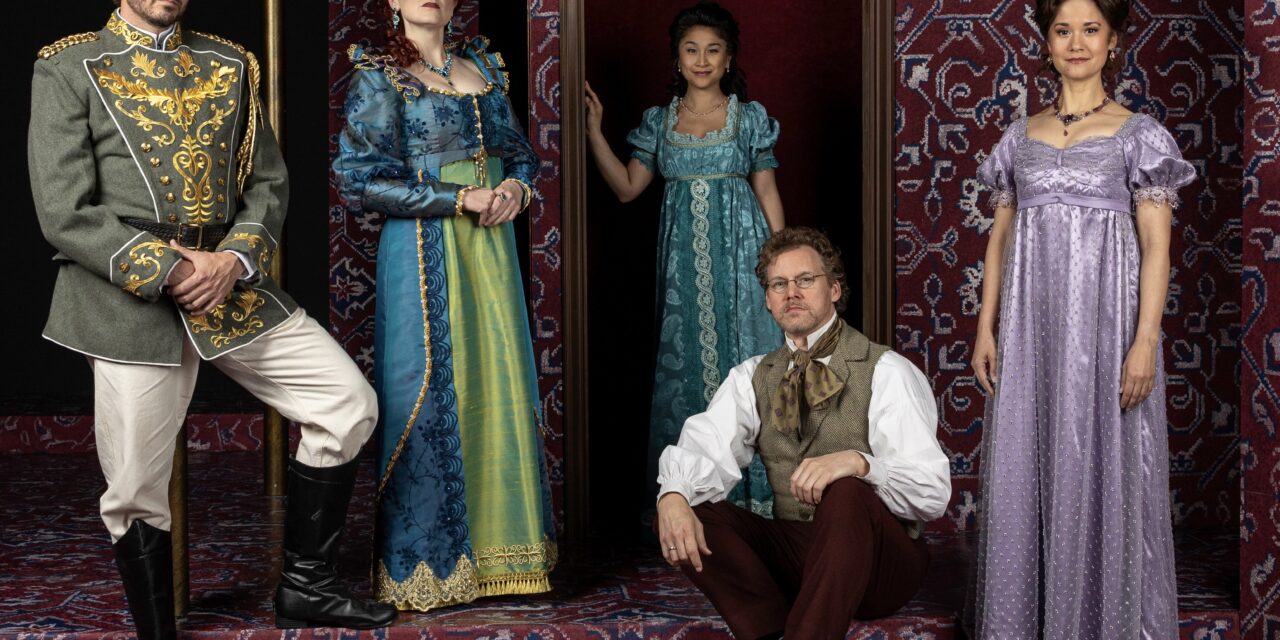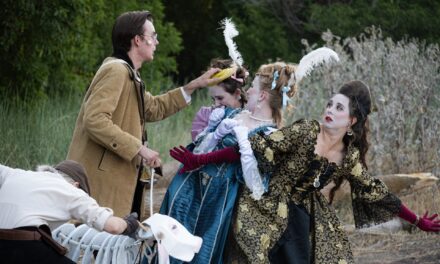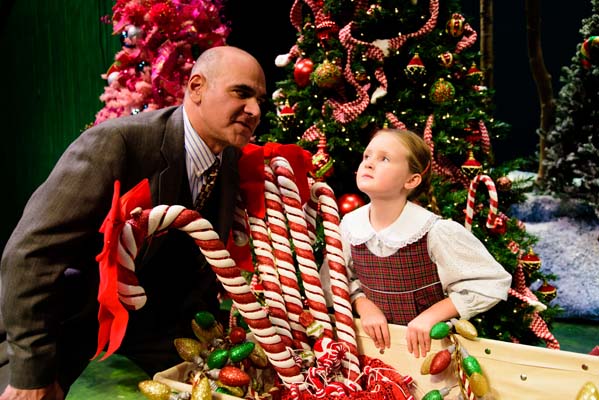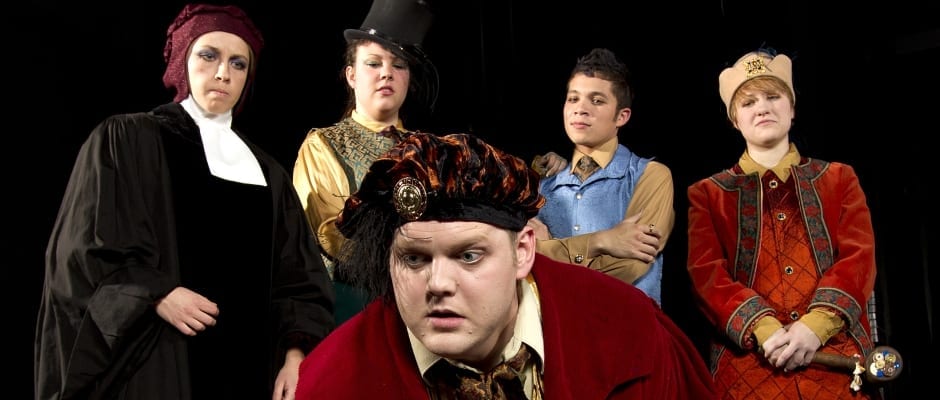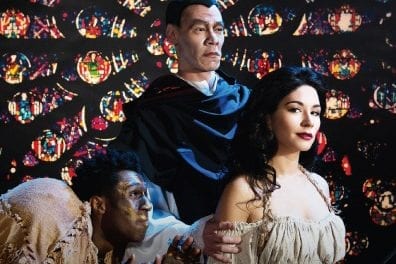SALT LAKE CITY — I can’t imagine the pitch for a Russian folk adaptation of Leo Tolstoy’s lengthy epic War and Peace with indie rock and EDM influences was an easy sell for composer and playwright Dave Malloy at first. Natasha, Pierre and the Great Comet of 1812, is written with an awareness of the density of the source material with a prologue that introduces the characters, implores audiences to refer to the program’s synopsis, and poses the major dramatic questions. It was a strong start aided by the preshow introduction from Pioneer Theatre Company’s artistic director Karen Azenberg. She came out to celebrate the 2023-2024 season, raised her drink to a exciting new season, and connected with the audience about the show she had masterfully directed and choreographed.
The musical is fast paced, entirely sung through, and dense with exposition at times. Azenberg’s incredible stage composition made it exceptionally easy to follow the action, keep sub plots in mind, and give the audience a clear focus point at all times. Archival video of this production could be a master class in staging. In the musical’s “Prologue”, several characters are highlighted in a witty and repititous pattern while a large ensemble is on stage. There’s never any doubt about where to look as crisp gestures, clever use of levels and lighting all help tell the story Azenberg has in mind.
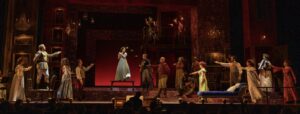
Natasha, Pierre and the Great Comet of 1812 plays at Pioneer Theatre Company through May 25, 2024 | Photo Credit: BW Productions.
In the number “Natasha & Anatole” Azenberg’s direction is able to exude fierce sexual tension from a number that is not explicit, revealing or particularly physical. Natasha and Anatole are intense in what they aren’t doing during the song. I loved the choice for Pierre, played by Kevin Earley, to be consistently on stage at his desk as people in other locales reveled around him. It showed his aloofness amongst such festivity. Over and over, the emotional parabolas and waves were communicated through precision blocking and choreography that helped guide the eyes from spectacular moment to spectacular moment.
The performance included live orchestration on stage that included passive players and musicians that wove into the ensemble. It was reminiscent of the national tour of Hadestown where the band is as much a part of the cast as the actors. At one point during a drinking song, actors go to Phil Reno, the show’s conductor, at a piano in front of the stage. He hands the actors a bottle of vodka, they pour shots, hand one to him and quip “he plays better this way.” The ensemble’s chemistry, enthusiasm, and camaraderie was essential to the success of this production and they delivered handsomely.
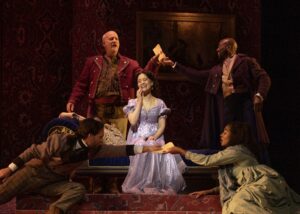
Photo Credit: BW Productions.
Technically the show was another absolute smash for PTC. I spoke glowingly about the production design for PTC’s Murder on the Orient Express and the technical elements for Natasha, Pierre were every bit as stellar. Patrick Holt’s costume design was exceptional. The costumes were elegant and graceful and served the vanity of Natasha and Hélène. They were conservative in cut and design, while still allowing the characters to thrill in how they revealed “arms, shoulders and neck”.
Earley made Pierre as exhilarating to watch as an aloof and austere man can be. I was impressed with his vocal control at the beginning of “Dust and Ashes” as he lay flat on a ramp center stage and still boomed “Am I dead?”. Earley had to navigate a delicate line as a man who needs to stand strong and virtuously against what he knows will harm others while not offering any justice for himself.
This musical isn’t so much Natasha and Pierre’s love story as much as it’s what make’s their love story possible. Given the events of the play, I was afraid that the love between the two would feel predatory as he expresses affection and admiration at her lowest point. However, he was instead gentle and warm. Like the image of the candle in two mirrors mentioned in the text, the love that could be between Pierre and Natasha in the play is largely left to our imaginations. Earley’s portrayal of Pierre makes it easy to conjure up a love that yields goodness and tenderness beyond pain and sorrow. I like to think it will be exactly that.
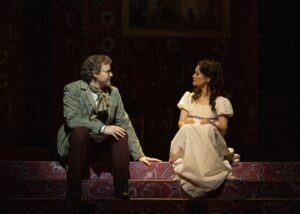
Photo Credit: BW Productions.
One of the show’s most impactful moments was when Mary Fanning Driggs as Marya lowered her pistol at Anatole and permeated the force of a matriarch. Her number afterwards about what happens “In My House” come almost out of nowhere. While “Marya is old school” had been a running theme, her sheer presence during that number was captivating.
The leading women were all exceptional and their interplay was a major strength of the production. Ali Ewoldt captured all that makes Natasha so entrancing and painful to watch. Ewoldt gave the character sweetness in moments where she would pine for Andrey and Anatole, and belied an immature belief that she could love both without consequences. Her progression from awed flattery to full-blown arrogance about her own charms led to a beautiful and strained relationship with Sonya. Melanie Fernandez who played Sonya had an exceptional voice. I could have listened to her mournful “Sonya Alone” again and again. Fernandez’ consistency as Sonya was a strong foil to Ewoldt’s evolution and eventual downfall as Natasha. Fernadez still showed a strong emotional range, but she delivered a character determined to faithfulness.
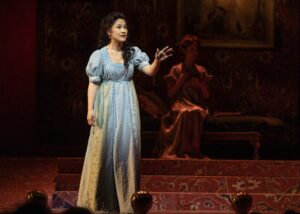
Photo Credit: BW Productions.
While Natasha, Pierre, and the Great Comet of 1812 is only a section of War and Peace, I feel like I could write a thousand pages about this production’s merits. Incredible performances from Aleks Pevec (Anatole), Ginger Bess (Hélène) and Bennett Chew (Andrey) will stick in my mind. Each actor was at the top of their craft, and it showed in their humor, voices, and presence. The live orchestra was beautiful and immersive. The show was a master work of scenic design by Jo Winiarski with seamless transitions that showed cohesion from the stage management end. This is the kind of show every theatre maker hopes to be part of in any capacity. Even the front of house elements were spectacular with a pop up mocktail counter, savory smelling foods and incredible hospitality.
The opening night production of this Utah premiere I attended happened under a massive Aurora Borealis. It was a good omen for a show that consistently looks to the cosmos. The show was a visceral reminder of why live artistic performance is uniquely necessary to culture and entertainment. Pioneer Theatre Company produced an elite performance that serves as a reminder of what a privilege it is to have equity caliber theatre makers and venues in Salt Lake City.

These reviews are made possible by a grant from the Salt Lake County Zoo, Arts, and Parks program.

